What’s the best way to tell area residents about plans for a new asylum shelter nearby?
The government should tell communities directly about plans for new asylum shelters, some activists and politicians say.
There are ways to make safer places, says Green Party Councillor Darcy Lonergan. “But instead you’re telling me, don’t go out at night.”

As the early evening darkened on Amiens Street last Wednesday, a group of women in high-viz jackets gathered on the footpath.
Darcy Lonergan, a Green Party councillor, handed out clipboards with a list of questions about safety issues that they may spot on streets, and ideas for improvements.
It’s frustrating for women to be told to just not use a public space if they feel unsafe, Lonergan said. “Why do I have to change my movement?”
There are ways to make safer places, she says. “But instead you’re telling me, don’t go out at night. It’s five o’clock.”
In response, Lonergan, as part of the council’s women’s safety working group, has brought some women together to this part of the north inner-city to stroll the streets and do a safety audit.
Lonergan says that Richard Shakespeare, the council’s deputy chief executive, has said he will allocate resources to deal with issues raised.
Aoife McNamara, her scarf wrapped to her chin, said as there’s been national attention on O’Connell Street, there might be an opportunity to improve the public realm in the area.
“I think a lot of it’s about investment, really, in our inner city, and investment in the people who live and are from here, as well,” she says. “People are aware now of the potential of what can be done in this area.”
Leaving their meeting spot, the group of 10 crosses the road and then splits into two.
“Soak up your surroundings,” says Cat O’Driscoll, a Social Democrats councillor, to a group of four as she leads them down Amiens Street.
The other group disappears around the corner onto Talbot Street.
“Anything that’s giving you signs,” O’Driscoll says. “A lot of them might be subconscious so you’ve to reflect on them. What’s making you feel unsafe here?”
The group pulls into the wall to let a woman holding a young boy’s hand fit by.
“It’s really narrow, and it’s hard to pass people,” says Gillian Clarke, looking up from her clipboard. “Uneven footpaths.”
A smelly rubbish truck parks a few feet away. “That’s quite intimidating, that’s like a big lorry right up beside you on a narrow footpath,” says Clarke.
It could block the view of someone approaching you, she says.
There are four lanes of traffic and two bus lanes, says Clarke. “And yet the people waiting for the bus, pedestrians, rubbish collection, are bunched up into a footpath that’s about a metre wide.”
In single file, the group squeezes through a crowd of commuters waiting at the bus stop, for a seat out of town on the 14 perhaps or the 15.
Whether it’s busy or not, space on the footpath makes a difference to how safe and comfortable you feel, says O’Driscoll.
She can feel unsafe and unsettled when someone pushes up against her to get by, she says. “I’m really conscious about, are my pockets zipped, you know, are they going to grope me up?”
If you end up waiting a long time for your bus, you could be in a potentially unsafe place for a long time, says McNamara. “You’re standing there by yourself, and they’re just driving by. It’s not a nice feeling.”
Space on the footpath particularly affects those walking with children, who are more often women, said Eimear Fox, a landscape architect for Transport Infrastructure Ireland (TII), separately on a later video call.
“Kids don’t go in a straight line,” she says. “Having a couple of spaces along the route that have a little bit more space can make the journey a lot easier for women.”
Around the corner on Store Street, commuters hunch into their coats waiting for the Luas. The tall Busáras office building looms over the street.
There’s a wide footpath here. But the group still feels it’s uncomfortable, they say, among themselves, marking the reasons down on their clipboards.
“It’s not very people-friendly, I can’t quite express why I think that,” says Clarke, looking up at the bus station, and across to the public square.
The Store Street Garda Station is just a few metres away. But it doesn’t make the area feel safer, says McNamara. The others murmur agreement.
“There’s not exactly a Garda presence outside,” McNamara says. “They’re not walking up and down.”

Fox said that a safe place is more than CCTV, which doesn’t help in the moment, and security guards, who can be intimidating. “That’s down to training as well,” she says.
On Store Street, there’s a sense of being on your own, said McNamara. There’s no safe pedestrian crossing to Busáras, no windows with warm yellow light denoting the presence of local residents.
One awful experience, or even one nervous feeling, might mean someone won’t go out next time, says Emer Delaney, putting away her clipboard.
“Am I going to be carrying my keys in my hands, listening out? It is a habit that many of us get into early, so much so that maybe we don’t think about it,” she says.
Local authorities have a duty to make public spaces safe for everyone, says Clarke.
The two groups meet again on the corner where North Earl Street, paved and open and pedestrianised, meets with busy O’Connell Street.
It feels lively here, says Clarke. The paving is even, comfortable to walk along, and there’s bright lighting, she says.
There are passers-by taking a moment to pause, setting down their bulging shopping bags, or leaning into walkers for a rest. “It’s not, everyone’s rushing through,” says O’Driscoll.
Lonergan walks from O’Connell Street through pedestrianised North Earl Street to where Talbot Street, and car access, begins.
On Talbot Street, like Amiens Street, the footpath feels narrow and inaccessible to wheelchairs or buggies, she says. “Your arms are killing you trying to get over the potholes [with a buggy].”
“Half the lights just aren’t working,” says Lonergan, pointing up at a dim streetlamp.
“This is supposed to be the centre of the capital city,” says O’Driscoll. “But our first impressions of this end of Talbot Street is that it’s a little bit neglected, a bit shabby.”
Fox says that if changes are made, the council should first audit who uses the street now. That way, it can see if the changes have worked, and if more women use the space.

For Luas Finglas, the planned extension to the Luas Green Line, TII is doing gender and age audits along the route, and chatting to people about what could be improved.
“Before this, the only way people were counted was how they related to crossings at junctions. So it was people’s interactions with vehicles,” she says.
“To actually understand who was on the streets. It seemed like a no-brainer, but that has never been done before,” she says.
Based on its 2020 report on women’s use of public transport, TII has prepared a checklist to use on transport projects on “applying a gender lens”.
A gender lens “provides a more complex understanding of mobility, recognising that people are ‘situated’ with families, roles, identities, fears, joys and thresholds”, it says.
The checklist tells the design team to examine its own gender divide and power dynamics, and to complete gender safety audits for its projects.
It also lists considerations like accessibility, childcare, cycling access and age. The checklist brings these issues to the forefront, says Fox. “So it’s not something that can be ignored.”
Fox says there should be women at all levels of decision making on street-design teams. “It’s a matter of prioritising approaches, and that needs to happen at a senior level as well as a junior level.”
Dublin City Council hasn’t yet responded to queries sent Tuesday as to whether it does gender and age audits of its transport projects.
Get our latest headlines in one of them, and recommendations for things to do in Dublin in the other.